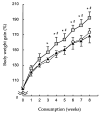Selective Consumption of Fish Oil at End of the Day Increases the Physiological Fatty Acid Compositions of Eicosapentaenoic Acid and Docosahexaenoic Acid in Mice
- PMID: 35209062
- PMCID: PMC8874613
- DOI: 10.3390/molecules27041271
Selective Consumption of Fish Oil at End of the Day Increases the Physiological Fatty Acid Compositions of Eicosapentaenoic Acid and Docosahexaenoic Acid in Mice
Abstract
Diets with high daily fat consumption are associated with excess weight. However, the effects of fat type and consumption timing on excess weight remain unclear. We investigated the selection of a 30% (w/w) fat diet of soybean oil (SOY), lard (LARD), and fish oil (FISH) on the metabolic parameters of mice. Male C57BL/6 mice were divided into the double SOY-box (w-SOY), SOY-box/LARD-box (SOY-vs-LARD), or SOY-box/FISH-box (SOY-vs-FISH) groups and allowed to selectively consume for 8 weeks. The total energy intake was similar for all groups, but the mice selectively chose to consume LARD over SOY and SOY over FISH. Body weight in the SOY-vs-LARD group was significantly higher than that in the w-SOY and SOY-vs-FISH groups. Additionally, minimal but selective consumption of an omega-3 fatty-acid-rich FISH diet at the end of the active period increased the physiological fatty acid compositions of eicosapentaenoic acid (EPA) and docosahexaenoic acid (DHA) in the SOY-vs-FISH group; their metabolic parameters were also lower than the SOY-vs-LARD group. In conclusion, selectively consuming small amounts of fish oil at the end of the day may prevent excess weight compared with LARD consumption.
Keywords: high-fat diet; mice; omega-3/omega-6 ratio; overweight; selectivity.
Conflict of interest statement
The authors declare no conflict of interest.
Figures






Similar articles
-
Diets enriched in menhaden fish oil, seal oil, or shark liver oil have distinct effects on the lipid and fatty-acid composition of guinea pig heart.Mol Cell Biochem. 1997 Dec;177(1-2):257-69. doi: 10.1023/a:1006871524271. Mol Cell Biochem. 1997. PMID: 9450671
-
Reduction in plasma glucose after lipid changes in mice fed fish oil, docosahexaenoic acid, and eicosapentaenoic acid diets.Ann Nutr Metab. 2006;50(2):147-54. doi: 10.1159/000090671. Epub 2006 Jan 2. Ann Nutr Metab. 2006. PMID: 16391470
-
Dietary alpha-linolenic acid lowers postprandial lipid levels with increase of eicosapentaenoic and docosahexaenoic acid contents in rat hepatic membrane.Lipids. 2001 Dec;36(12):1331-6. doi: 10.1007/s11745-001-0849-7. Lipids. 2001. PMID: 11834085
-
Effects of fish oil in parenteral nutrition.Nutrition. 2003 Mar;19(3):275-9. doi: 10.1016/s0899-9007(02)01009-2. Nutrition. 2003. PMID: 12620534 Review.
-
Myocardial membrane fatty acids and the antiarrhythmic actions of dietary fish oil in animal models.Lipids. 2001;36 Suppl:S111-4. doi: 10.1007/s11745-001-0692-x. Lipids. 2001. PMID: 11837983 Review.
Cited by
-
Daily Consumption of α-Linolenic Acid Increases Conversion Efficiency to Eicosapentaenoic Acid in Mice.Nutrients. 2024 May 7;16(10):1407. doi: 10.3390/nu16101407. Nutrients. 2024. PMID: 38794645 Free PMC article.
-
Opposite effects of low-carbohydrate high-fat diet on metabolism in humans and mice.Lipids Health Dis. 2023 Nov 10;22(1):191. doi: 10.1186/s12944-023-01956-3. Lipids Health Dis. 2023. PMID: 37950240 Free PMC article.
-
Nutritional composition, heavy metal contents and lipid quality of five marine fish species from Cameroon coast.Heliyon. 2023 Feb 28;9(3):e14031. doi: 10.1016/j.heliyon.2023.e14031. eCollection 2023 Mar. Heliyon. 2023. PMID: 36938409 Free PMC article.
-
The Anti-Obesity Effect of Fish Oil in Diet-Induced Obese Mice Occurs via Both Decreased Food Intake and the Induction of Heat Production Genes in Brown but Not White Adipose Tissue.Int J Mol Sci. 2024 Dec 31;26(1):302. doi: 10.3390/ijms26010302. Int J Mol Sci. 2024. PMID: 39796158 Free PMC article.
References
MeSH terms
Substances
Grants and funding
LinkOut - more resources
Full Text Sources
Medical
Research Materials

